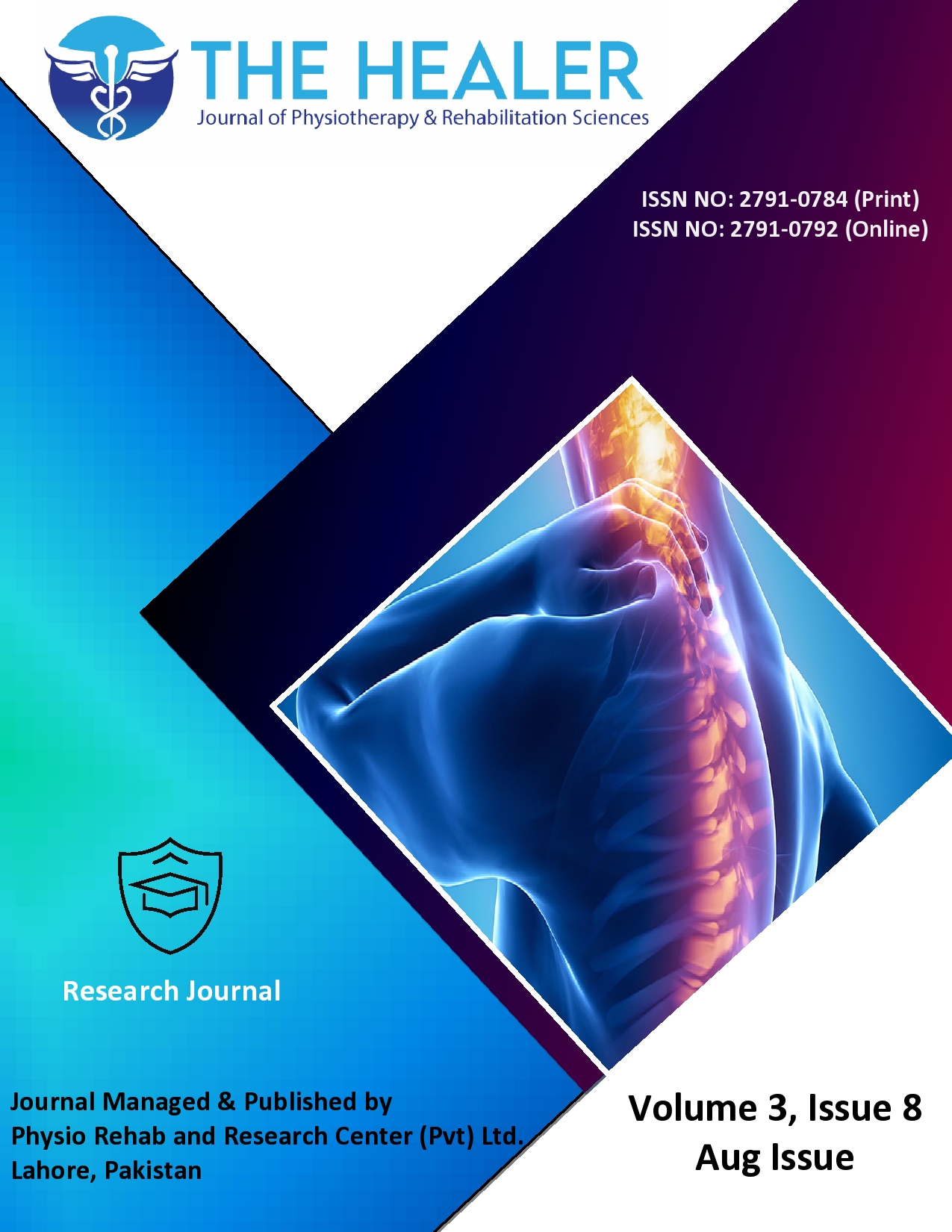Prevalence of Diastasis Recti Abdominis and Its Impact on Quality of Life in Association with Low Back Pain After Postpartum; A Cross-Sectional Study
Diastasis Recti Abdominis & LBP After Postpartum
DOI:
https://doi.org/10.55735/hjprs.v3i8.177Keywords:
diastasis recti abdominis, low back pain, postpartum, quality of lifeAbstract
Background: After giving birth, a woman experiences numerous anatomical and physiological changes, including changes in hormone order, blood loss, uterine contractions and more. These changes can lead to postpartum problems such as postpartum hemorrhage, postpartum endometritis, depression and diastasis recti which contributes to frequent health problems such as lower back discomfort in new mothers. Women who have diastasis recti are more prone to experience more severe abdominal and pelvic pain. Objective: To determine the prevalence of diastasis of recti abdominis and its impact on quality of life in association with low back pain after postpartum. Methods: This cross-sectional study was conducted from September 2022 to March 2023 at Al-Shafi Clinic, Mother Care Hospital. The study followed 300 first-time mothers from conception to 12 months after giving birth. Data was collected from female participants who fulfilled inclusion and exclusion criteria. Consent was taken from them to ensure their voluntary participation before data collection. Then a manual test named a two-finger test was performed to diagnose diastasis recti.The Oswestry low back index and WHO quality of life questionnaire were used as outcome measure tools filled by a therapist by asking questions from participants. Data was evaluated by SPSS version 21 and descriptive statistics were presented as frequency tables, mean standard deviation, mode, bar chart, pie chart and histograms. Results: The mean age of the candidate was 33.99±4.13years. Differential statistics are calculated by different parametric tests. The chi-square test was used between the deliveries and the two-finger test. Cross tabulation was applied to compare quality of life and low back pain. the study recruited were 300 (100%) females. minimum no.of deliveries 1.00 and maximum 6.00. shown that the maximum number of participants was positive 292 after the chi-square test was applied. Conclusion: It is concluded that diastasis recti abdominis has a significant association with low back pain that affects the life quality post-partum. It showed quality of life was majorly impacted by diastasis recti abdominis as social health and general health were affected more than environmental health and physiological health due to diastasis recti abdominis.
References
Sperstad JB, Tennfjord MK, Hilde G, Ellström-Engh M, Bø K. Diastasis recti abdominis during pregnancy and 12 months after childbirth: prevalence, risk factors and report of lumbopelvic pain. British journal of sports medicine 2016; 50(17): 1092-6.
Thabet AA, Alshehri MA. Efficacy of deep core stability exercise program in postpartum women with diastasis recti abdominis: a randomised controlled trial. Journal of musculoskeletal & neuronal interactions 2019; 19(1): 62.
Michalska A, Rokita W, Wolder D, Pogorzelska J, Kaczmarczyk K. Diastasis recti abdominis—a review of treatment methods. Ginekologia polska 2018; 89(2): 97-101.
Boissonnault JS, Blaschak MJ. Incidence of diastasis recti abdominis during the childbearing year. Physical therapy 1988; 68(7): 1082-6.
Jessen ML, Öberg S, Rosenberg J. Treatment options for abdominal rectus diastasis. Frontiers in surgery 2019; 6: 65.
Bø K, Hilde G, Tennfjord MK, Sperstad JB, Engh ME. Pelvic floor muscle function, pelvic floor dysfunction and diastasis recti abdominis: prospective cohort study. Neurourology and urodynamics 2017; 36(3): 716-21.
Da Mota PGF, Pascoal AGBA, Carita AIAD, Bø K. Prevalence and risk factors of diastasis recti abdominis from late pregnancy to 6 months postpartum, and relationship with lumbo-pelvic pain. Manual therapy 2015; 20(1): 200-5.
Aparicio LF, Rejano-Campo M, Donnelly GM, Vicente-Campos V. Self-reported symptoms in women with diastasis rectus abdominis: a systematic review. Journal of Gynecology Obstetrics and Human Reproduction 2021; 50(7): 101995.
Spitznagle TM, Leong FC, Van Dillen LR. Prevalence of diastasis recti abdominis in a urogynecological patient population. International urogynecology journal 2007; 18: 321-8.
Doubkova L, Andel R, Palascakova-Springrova I, Kolar P, Kriz J, Kobesova A. Diastasis of rectus abdominis muscles in low back pain patients. Journal of back and musculoskeletal rehabilitation 2018; 31(1): 107-12.
Gandhi B, Dhankar S. Impact of Diastasis Recti Abdominis and low back pain on Quality Of Life in Post-partum female. Indian Journal of Forensic Medicine & Toxicology 2021; 15(1): 887-9.
Benjamin DR, Frawley HC, Shields N, van de Water AT, Taylor NF. Relationship between diastasis of the rectus abdominis muscle (DRAM) and musculoskeletal dysfunctions, pain and quality of life: a systematic review. Physiotherapy 2019; 105(1): 24-34.
Acharry N, Kutty RK. Abdominal exercise with bracing, a therapeutic efficacy in reducing diastasis-recti among postpartal females. Int J Physiother Res 2015; 3(2): 999-05.
Nahabedian MY. Management strategies for diastasis recti. Seminars in Plastic Surgery; 2018: Thieme Medical Publishers; 2018. p. 147-54.
Carrara A, Catarci M, Fabris L, et al. Prospective observational study of abdominal wall reconstruction with THT technique in primary midline defects with diastasis recti: clinical and functional outcomes in 110 consecutive patients. Surgical Endoscopy 2021; 35: 5104-14.
Chiarello CM, Falzone LA, McCaslin KE, Patel MN, Ulery KR. The effects of an exercise program on diastasis recti abdominis in pregnant women. Journal of women’s health physical therapy 2005; 29(1): 11-6.
Fiori F, Ferrara F, Gobatti D, Gentile D, Stella M. Surgical treatment of diastasis recti: the importance of an overall view of the problem. Hernia 2021; 25: 871-82.
Mota P, Gil Pascoal A, Bo K. Diastasis recti abdominis in pregnancy and postpartum period. Risk factors, functional implications and resolution. Current women's health reviews 2015; 11(1): 59-67.
Rotstein E. Pelvic floor dysfunction after childbirth: symptoms, diagnosis, treatment. 2022.

Published
How to Cite
License
Copyright (c) 2023 The Healer Journal of Physiotherapy and Rehabilitation Sciences

This work is licensed under a Creative Commons Attribution 4.0 International License.
CC BY


